A project of the Manship School of Mass Communication, LSU
"The new Congress is 91% Christian. That's barely budged since 1961."
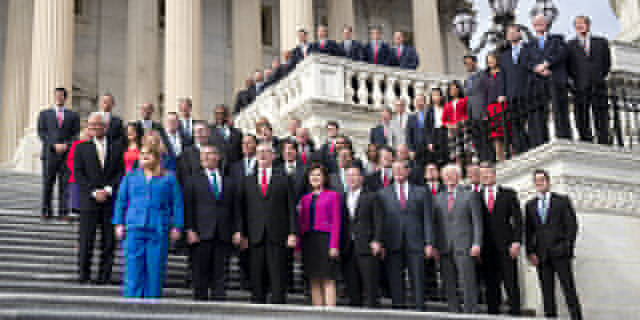
By Debra Mason
The Pew Research Center’s new report entitled “Faith on the Hill” has found that the religious beliefs of those in congressional leadership have remained consistently Christian despite the American population’s progression toward more diversified belief systems (Bromwich, 2017). The center’s research found that over 90% of the 115th Congress reported “identified as Christian” with only a 4% decline occurring since 1961. The report’s author, Aleksandra Sandstrom, stated that “’Congress is really, at least religiously, staying very, very steady’”(2017). In fact, Pew stated that “[o]nly one member of Congress has ever said that he does not believe in some form of God” (2017). Overall, more diversity of religions was found in Democrats as compared to Republicans, with only 80% of the current Congress’s Democrats identifying as Christian as compared to 99% of Republicans (2017). While it is unsurprising that the majority of Congress is religious since the American public has indicated that they would be disinclined to vote for a “presidential candidate who does not believe in God,” it is difficult to determine why the overarching “religious composition of Congress” has maintained such great consistency. To read the full Pew report, click here.
Bibliography:
Bromwich, J. E. (2017, January 3). The New Congress is 91% Christian. That's Barely Budged Since 1961. Retrieved from The New York Times
"22 powerful posts from people of faith at the Women's March"
By Debra Mason
This piece shows a variety of social media posts from Women’s Marches that took place across the country on January 22, 2017. The focus, however, is placed on individuals of a variety of different faiths, including “Muslims, Christians, Jews, Buddhists, Sikhs, and many more” (Kuruvilla, 2017). These individuals used their faiths to try to establish unity toward one common goal in the midst of their differences. Click here to see the posts from the Women's March.
Bibliography:
Kuruvilla, C. (2017, January 23). 22 Powerful Posts from People of Faith at the Women's March. Retrieved from The Huffington Post
Reporter's notebook: What it was like as a Muslim to cover the election

(Dec. 7, 2016 | NPR) - NPR Editor's note: There is language in this piece that some will find offensive.
Sometime in early 2016 between a Trump rally in New Hampshire, where a burly man shouted something at me about being Muslim, and a series of particularly vitriolic tweets that included some combination of "raghead," "terrorist," "bitch" and "jihadi," I went into my editor's office and wept.
I cried for the first (but not the last) time this campaign season. Read more
Pew study: Religions vary in educational attainment
(Dec. 13, 2016 | Pew Research Center) - Jews are more highly educated than any other major religious group around the world, while Muslims and Hindus tend to have the fewest years of formal schooling, according to a Pew Research Center global demographic study that shows wide disparities in average educational levels among religious groups. Read more
Research Brief
Night and Day: An Illustration of Framing and Moral Foundations in the Oklahoma Shariah Amendment Campaign
Bibliography:
Bowe, B. J., & Hoewe, J. (2016). Night and Day: An Illustration of Framing and Moral Foundations in the Oklahoma Shariah Amendment Campaign. Journalism & Mass Communication Quarterly, 967-985.
Summary: In this article, Bowe and Hoewe discuss a content analysis they conducted on letters to the editors of The Oklahoman and The Tulsa World between June 1, 2010 and December 31, 2012 regarding Oklahoma’s “Save Our State” amendment in 2010. Continue reading.
By Debra Mason
Research Brief:
Framing terror: The strategies newspapers use to frame an act as terror or crime
Bibliography: Morin, A. (2016). Framing Terror: The Strategies Newspapers Use to Frame an Act as Terror or Crime. Journalism & Mass Communication Quarterly, 986-1005.
Summary: This study includes a comparative analysis of news reporting of the 2009 Ft. Hood, Texas shooting by U.S Army psychiatrist Major Nidal Malik Hasan and the 2013 Washington, D.C., Navy Yard shooting by “…Navy contractor and former Navy reservist,” Aaron Alexis (Morin, 2016). Continue reading.
By Debra Mason
New series on 'The Secret Life of Muslims' aims to subvert stereotypes
By Debra Mason
When Egyptian-American actor Ahmed Ahmed decided to tell his agent to stop bringing him in for parts of terrorists and villains, he found his acting career come to a halt. However, instead of maintaining complacency, he discovered how he could use his words to fight stereotyping through stand-up. Ahmed stated that it “allowed him ‘to have a voice to talk about being Muslim in a funny way’” (Blumberg, 2016). Now, he has taken his efforts a step further by combatting this view through his new web series, “The Secret Life of Muslims,” which recently premiered on Vox (Blumberg, 2016). In altering negative or fearful perceptions that plague over half of the nation, partially as a result of Hollywood’s portrayal, Ahmed hopes to show a new perspective regarding the truth about American Muslims and all they do and accomplish in the nation (Blumberg, 2016). To watch the first episode, click here.
Bibliography:
Blumberg. (2016, November 4). New Series on 'The Secret Life of Muslims' Aims to Subvert Stereotypes. Retrieved from Huffington Post Religion: http://www.huffingtonpost.com/entry/new-series-on-the-secret-life-of-muslims-aims-to-subvert-stereotypes_us_581b9c9ee4b0d9ce6fbab859?section=us_religion
One-in-five U.S. adults were raised in interfaith homes
By Debra Mason
Even though mixed religious backgrounds in American families is still rare with 80% of U.S. adults raised within households of a single religion, interfaith homes are slowly becoming more common (Pew Research Center, 2016). Roughly 1 out of every five adults were brought up in interfaith homes, 10% of whom had parents of differing religious and 12% of whom had one religiously affiliated parent and one religiously unaffiliated (2016). Read more
Pew Research Center. (2016, October 26). One-in-Five U.S. Adults Were Raised in Interfaith Homes. Retrieved from Pew Research Center: http://www.pewforum.org/2016/10/26/one-in-five-u-s-adults-were-raised-in-interfaith-homes/
Book Review
Networked Theology: Negotiating Faith in Digital Culture
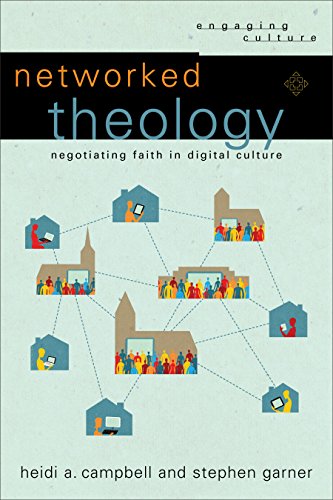
By Debra Mason
(Oct. 29, 2016) - Utilizing a framework of theological anthropology, Garner and Campbell tackle the topic of human and social identity in the midst of an increasingly digital, networked culture. In doing so, they analyze the interconnectivity of Christian faith and theology in the digital, technology-driven world. Garner’s computer science background combined with Campbell’s media studies experience provide unique perspectives on this subject, its impact on faith practices and facilitating religious experiences, and the compounding responses of this digital engagement in faith-based communities from blogs and podcasts to discussions of beliefs on social media.
In the introduction, they write, “While many books have sought to offer a Christian theological reflection on digital technologies, few have presented clear, systematic investigations that not only allow readers to reflect deploy on how the characteristics of new media correlate with emerging social practice but also provide concrete resources for evaluating the theological trajectory created by new media values.” Networked Theology: Negotiating Faith in Digital Culture is published and available for purchase.
Bibliography:
Campbell, Heidi A. and Garner, Stephen (2016). Networked Theology: Negotiating Faith in Digital Culture. Grand Rapids: Baker Publishing Group.
"A Catholic Charity is reaching out to transgender people in India, just not all of them"
Contributed by Debra Mason
The Catholic social welfare organization in India entitled Caritas India is starting a program to work with transgender individuals, which makes up over half a million people in their population (Blumberg, 2016).
Though working to counter the prejudice that often exists against this community, the group’s outreach only extends to those “…classified as ‘biological transgenders,’ which [can be] denoted [as] those who identify with a different sex but have not undergone surgery” (Blumberg, 2016). The executive director, Rev. Frederick D’Souza, explained that they are not in favor of transgender people actually undergoing a sex change (Blumberg, 2016). Read more
Bibliography:
Blumberg, A. (2016, October 21). A Catholic Charity is Reaching Out to Transgender People in India, Just Not All of Them. Retrieved from The Huffington Post: http://www.huffingtonpost.com/entry/a-catholic-charity-is-reaching-out-to-transgender-people-in-india-just-not-all-of-them_us_580a5548e4b000d0b1566b5e?section=§ion=us_religion
Pew video: Israel's religiously divided society
Contributed by Debra Mason
Supplementing Pew Research Center’s March 2016 report entitled, “Israel’s Religiously Divided Society,” the center recently released a video to discuss the divide and discrimination that exists within the Jewish community (between Haredis, Datis, Masortis, and Hilonis) as well as between Jews and Arabs with regard to their political and religious viewpoints (Pew Research Center, 2016). This study investigates the separation that exists within this small country despite the many traditions that are shared (Pew Research Center, 2016). Some of the key areas of contention with regard to public policy include “marriage, divorce, religious conversion, military conscription, gender segregation and public transportation,” in addition to differences in belief systems and religious identities (Pew Research Center, 2016).
Bibliography:
Pew Research Center. (2016, October 13). Video: Israel's Religiously Divided Society. Retrieved from Pew Research Center: http://www.pewforum.org/2016/10/13/video-israels-religiously-divided-society/
"Choosing to stay in the Mormon Church despite its racist legacy"
By Janan Graham-Russell
(Aug. 28, 2016 | The Atlantic) - This article from The Atlantic tells the religious journey of a woman named Janan Graham-Russel, a woman who grew up in a home with a Protestant mother and a Muslim father, but became a member of The Church of Jesus Christ of Latter-day Saints in her late college years. She explains the trials that she faces being part of a community that had a history of discriminating against black members (“…black members had been banned from joining the priesthood or from performing specific rituals, from the mid-19th century until 1978…); Graham-Russell has witnessed the frustration felt by black Mormons at some leadership’s unwillingness to speak about these years of prejudice (Graham-Russell, 2016). However, she has been a part of the Mormon church for six years as a result of being drawn to the “communal” experience of the Mormon church, her feelings of reconnection with her “notions of blackness” as a result of being part of this community, and her renewed relationship with God (Graham-Russell, 2016). She writes: “My faith offers both solace and struggle: I have found solidarity among the often-weary voices of African American Mormons, who must work to affirm their spiritual and physical lives in a Church where those lives didn’t always matter” (Graham-Russell, 2016). She goes on discuss an interesting account of the history of the Mormon faith and its interweaving with race. To read the full article, click here.
Bibliography:
Graham-Russell, J. (2016, August 28). Choosing to Stay in the Mormon Church Despite Its Racist Legacy. Retrieved October 3, 2016, from The Atlantic: http://www.theatlantic.com/politics/archive/2016/08/black-and-mormon/497660/
30 years later, a sculpture of Jesus as a nude woman finally gets its due
Contributed by Debra Mason
Despite the controversy resulting from this artwork approximately 30 years ago, “Christa,” a “4-foot, 250-pound” depiction of Christ as a nude woman, is once again being featured in New York’s Cathedral Church of St. John the Divine (Frank, 2016).
Edwina Sandys, artist of “Christa” and daughter of Winston Churchill, says the decision to make this form was nearly automatic back when she completed the work in three days back in 1974 (Frank, 2016). She described the work as feminist, but said the goal was to appeal to the mutual suffering of both men and women, though this statue distinctly represents the “suffering of women” (Frank, 2016). In an interview in 2015, she stated, “Today women are finding their way to take their place in the Christian church and in society in general. Most women of my generation have been stamped with the idea of Man’s superiority over Woman, which is hard to throw off without seeming aggressive…” (Frank, 2016).
Bibliography:
Frank, P. (2016, October 6). 30 Years Later, A Sculpture of Jesus as a Nude Woman Finally Gets Its Due. Retrieved October 10, 2016, from HuffPost: http://www.huffingtonpost.com/entry/christa-edwina-sandys-art_us_57f55296e4b0b7aafe0b8999?section=§ion=us_religion
"Women atheists are genuinely considered monsters"
(Sept. 18, 2016 | The Atlantic) - In an interview with author of Village Atheists and Washington University professor Leigh Eric Schmidt, Green explores the common negative stereotyping and suspicions to which atheists are often subjected (Green, 2016). Although a relatively small portion of the population at only three percent primarily comprised of “white, male, and highly educated” individuals, the women who identify with this group are often marginalized to an even greater extent (Green, 2016). This stems from both the general population as well as the male-dominant atheist community. In his dialogue with Green, Schmidt explains that due to the fact that a great number of women attended and supported church services, especially in the 19th century, “there is an association with churches and pious femininity and domesticity” (Green, 2016). As a result, there is often a fear of the effect of women’s voices on the atheist agenda within this community, as well as a sense of “horror” from the general population due to the previously formed association of women and church; this makes it especially difficult for women to escape the socially-constructed negative stereotype (Green, 2016). However, the suspicion is deeper than just a gender divide, encompassing the male atheists as well due to a general lack of trust and perception of chaos. Schmidt wrote this book to acknowledge these prejudices, and to take them on to support minority rights (Green, 2016). To read more of the interview, click here.
Bibliography:
Green, E. (2016, September 18). 'Women Atheists Are Genuinely Considered Monsters'. Retrieved September 19, 2016, from The Atlantic: http://www.theatlantic.com/politics/archive/2016/09/village-atheists-history-nonbelief-united-states/499520/
NEW BOOK
Village atheists: How America's unbelievers made their way in a Godly nation
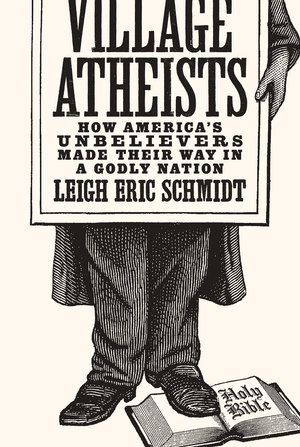
(Source: Princeton University Press) - In his new book, Schmidt explores the challenges and marginalization that atheists have faced throughout American history. Often pegged to be a moral threat to society, many secularists have had to withstand social exclusion and lack of acceptance from their religious counterparts. Using stories from “…itinerant lecturer Samuel Porter Putnam; rough-edged cartoonist Watson Heston; convicted blasphemer Charles B. Reynolds; and atheist sex reformer Elmina D. Slenker…”, the author provides accounts on the history of secularism in combination with everyday confrontations of these individuals as they navigate the “complex cultural terrain” in public life (Schmidt, 2016). From being identified as “godless freethinkers” through end of the nineteenth century to attaining “a measure of legal vindication” in the twentieth century,” Schmidt captures the atheist minority perspective in a nation with faith and citizenship continue to be closely intertwined (Schmidt, 2016).
Bibliography:
Schmidt, L. E. (2016). Village Atheists: How America's Unbelievers Made Their Way in a Godly Nation. Princeton: Princeton University Press.
What do Americans look for in a church, and how do they find one? It depends in part on their age
(Aug. 23, 2016 | Pew Research Center) - 50% of Americans have sought out a new house of worship in their lifetime; however, their methods of approaching this journey vary greatly depending on the age of the individual (Masci, 2016).
While it may not be surprising that more young adults turned to the internet than those who are older to do research on churches, it may be more unexpected that those who were under 30 were also significantly more likely to reach out to a congregation member or friend to gain recommendations for this transition. Both age groups found the “quality of sermons” to be a significant factor in making this decision, with 87% of young people identifying this as an area of great importance along with 77% of older people (Masci, 2016). Older age groups prioritized religious education more so than those who are younger (Masci, 2016). The style of worship, sense of feeling welcome and location of the church were also common factors that impacted this selection (Masci, 2016). To learn more about the findings, please visit this site.
Bibliography:
Masci, D. (2016, August 23). What do Americans look for in a church, and how do they find one? It depends in part on their age. Retrieved from Pew Research Center: http://www.pewresearch.org/fact-tank/2016/08/23/what-do-americans-look-for-in-a-church-and-how-do-they-find-one-it-depends-in-part-on-their-age/
New Book
Brand Islam: The marketing and commodification of piety
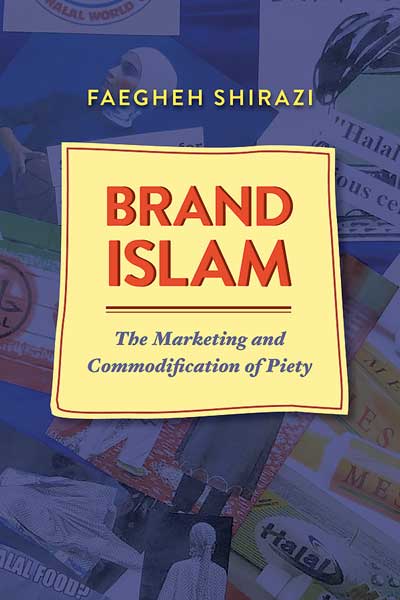
In an effort to capitalize on materialistic commodities, a wide range of products have begun to be marketed as “halal,” which is considered as being lawful or “Islamic” for many Muslims. However, many of the items being labeled as such have not been created or produced in order “….to honor religious practice or sentiment” (Shirazi, 2016). Brand Islam explores this marketing strategy and the loyalty that comes about from Muslim consumers as a result of this tactic. This has yielded what Shirazi considers to be “a new type of global networking” that will prove to significantly impact “….the religious, cultural, and economic lives of Muslim consumers” (Shirazi, 2016). To learn more about this book and to delve into the commercialization of Islam, visit: http://readingreligion.org/books/brand-islam
Bibliography:
Shirazi, F. (2016). Brand Islam: The Marketing and Commodification of Piety. Austin: University of Texas Press.
Which U.S. religious groups are oldest and youngest?

By Michael Lipka
(July 11, 2016 | Pew Research Center) - The religious make-up of the United States has gone through dramatic transitions in religious identities in recent years, with age serving as a major factor in projecting how religions will grow in the coming years (Lipka, 2016).
Many traditional evangelical and mainline Christian denominations such as the Presbyterian Church in America and the Presbyterian Church (U.S.A) have a median age of 59 for their community members, with only 10% of adults in these denominations existing in the under 30 age bracket (Lipka, 2016); comparatively, the Mormon, Orthodox Christian, and Seventh-Day Adventists faiths have an overall younger demographic as compared to other Christian sects (Lipka, 2016).
Meanwhile, the religious “nones” and non-Christian faiths such as U.S. Muslims and Hindus, have median ages of 36 and 33 respectively (Lipka, 2016). While age cannot be the only factor that can be taken into account when evaluating the future of a denomination, this element in combination with potential child birth leads one to believe that younger demographics in churches will likely present the greatest opportunity for those congregations to grow as children are brought into the church and members have longer life expectancies. To read more, visit this link.
Trends in global restrictions on religion
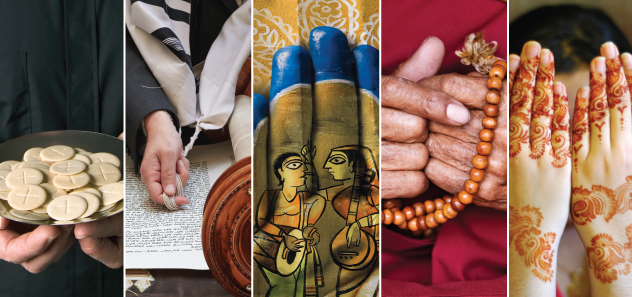
(June 23, 2016 | Pew Research Center) - The Pew Research Center conducted a study of 198 countries to assess the level of governmental restrictions and social hostilities involving religion, concluding that there has been an overall decline in both areas despite increased religion-related terrorism in 2014 (Pew Research Center, 2016). It was found that the number of countries experiencing high/very high levels of government restrictions and social hostilities toward religion declined from 28 to 24% and from 27 to 23% respectively from 2013 to 2014 (Pew Research Center, 2016). However, some of the most restrictive and hostile regarding religion are also some of the most populous countries, resulting in approximately 74% of the world’s people experiencing these conditions (Pew Research Center, 2016). While religion-related terrorism has increased from 73 to 82 of the 198 countries, counted as a social hostility for the purposes of this study, alternative forms of social hostility involving religion offset this increase (Pew Research Center, 2016).
This study also compared levels of governmental restrictions on religion and social hostilities according to regions, as well as the locations where there was greatest increase in religion-related terrorist activities in 2014, all of which can be observed in the graphs below. The overall conclusions of these studies were that the Middle-East/North Africa continued to encounter both the highest levels of restrictions as well as social hostilities, while the Asia-Pacific region experienced the most substantial increase in terrorist activity in 2014. To read more, visit the Pew Research Center’s site to read the full study.
Source: Pew Research Center. (2016, June 23). "Trends in Global Restrictions on Religion." Retrieved June 27, 2016, from Pew Research Center
The complicated pain of America's Queer Muslims
(June 14, 2016 | The Atlantic) - The aftermath of Orlando’s historic mass shooting has caused contentious arguments regarding both Islamophobia and homophobia (Graham, 2016). Often discussed separately as two different issues, Muslims of the LGBTQ community often experience both simultaneously (Graham, 2016). Graham’s article voices the struggles experienced by LGBTQ Muslims, as well as the confusion and trauma felt following Sunday’s early morning shooting; two of the individuals interviewed for this story are members of Muslims for Progressives as well as the Muslim Alliance for Sexual and Gender Diversity (Graham, 2016). A third named El-Farouk Khaki, an immigration lawyer and activist who lives in Toronto, expressed how many LGBTQ Muslims often do not experience of full acceptance into either community, causing a sense identity crisis (Graham, 2016). They feel that the two communities often feel antagonistically toward one another, missing the intersectionality that needs to occur for LGBTQ Muslims (Graham, 2016). “In 2009, Khaki co-founded El-Tawhid Juma Circle, a queer-affirming prayer space,” which was intended to allow people to feel free to open and expose who they truly are (Graham, 2016). Yet, LGBTQ Muslims are frequently subjected to violence and harassment. To read more, click here.
10 facts about atheists
(June 1, 2016 | Michael Lipka, The Atlantic) - The Pew Research Forum has compiled a list of ten facts that allow for better understanding of atheists and their beliefs in the midst of a time when the United States’ number of individuals who describe themselves as nonbelievers has substantially increased.
1. The number of Americans who identify as atheists has nearly doubled from the 1.6% reported in 2007 to 3.1%; simultaneously, the number of Americans describe themselves as agnostic has also increased from 2.4% in 2007 to 4% (Lipka, 2016).
2. Demographically, atheists are more likely to be young and males as compared to the general population, as well as highly educated and Caucasian (Lipka, 2016).
3. The majority of “self-identified atheists” tend to be democrats and would describe themselves as politically liberal (Lipka, 2016).
4. While often thought to be a group who does not believe God exists, this is not true of every atheist. “…8% of those who call themselves atheists also say they believe in God or a universal spirit” (Lipka, 2016).
5. While the overwhelming majority of atheists would not describe themselves as “religious,” there is still a sense of spirituality for at least 31%, and over half say they experience a sense of “wondering” about the universe (Lipka, 2016).
6. Two-thirds of atheists choose to never or rarely discuss religion with those who identify as religious (Lipka, 2016).
7. “Virtually no atheists (1%) turn to religion for guidance on questions of right and wrong, but increasing numbers are turning to science” (Lipka, 2016).
8. Americans often do not feel warmly about atheists, giving them a 41 on 100-point scale where zero is the most negative and 100 is the most positive (Lipka, 2016).
9. “About half of Americans (51%) say they would be less likely to support an atheist candidate for president…” (Lipka, 2016).
10. 45% of Americans view belief in God as “…necessary to have good values,…”, while 53% also believe that having a strong sense of morality is not directly related to this belief (Lipka, 2016).
To read more, click here.
Rainbow Mormon Initiative
(May 24, 2016 | Mette I. Harrison, HuffPost Religion)- Beginning on June 5, “…exactly 7 months from the leaked policy change which labels same-sex married Mormons ‘apostates’ and will be threatened with excommunication,” the Rainbow Mormon Initiative, a group led by Kristy Money, will begin their efforts to show support of their LGBT+ brothers and sisters (Harrison, 2016). This encouragement will be realized in the form of rainbow ribbons worn to church, in addition to the knitting or crocheting of “…scarves, hats, or blankets to donate to Ogden Youth Futures, a shelter for homeless LGBT teens in northern Utah” (Harrison, 2016). Money, inspired by “…her dissertation on suicide prevention in Utah,” saw this as an opportunity to help “gain visibility for LGBT+ Mormon issues…” (Harrison, 2016). The beginning of their efforts start on the day of Salt Lake City’s Pride Parade, a day that is also a “Fast Sunday” for Mormons (Harrison, 2016). To read more, click here.
Pew survey: Gender gap in religious service attendance has narrowed in U.S.
Contributed by Debra Mason (Originally reported by David McClendon, Pew Research Center on May 13, 2016)
Gender gaps are declining globally with regard to the attendance of Christian worship services (McClendon, 2016). 36% of women and 26% of men were attending religious services in 1972; however, while men and women have both dropped in their attendance of worship services, women have made a more notable decline to 28% as of 2012 versus 22% of men, thus decreasing the gap from 10% to 6%. One proposed theory for this narrowing gap is the adjustment in “women’s labor force participation” (McClendon, 2016); overall, it appears those women who are involved in the labor force attend services less frequently as compared to those outside of the labor force (McClendon, 2016).
However, this cannot be a definitive explanation as a major surge in women’s full-time employment “…occurred in the late 1970s and early 1980s, during which time the gender gap on religious service attendance actually widened somewhat” (McClendon, 2016). An additional theory proposed is the increase “…in women’s educational attainment” that has occurred within this time period has caused the decline, yet this does not seem to provide a clear explanation as both college-educated and less-educated women appear to have similar attendance rates as well as drops in attendance during this period (McClendon, 2016).
Finally, religious affiliation has garnered some attention with regard to this trend, as the number of women who claim to have no religious affiliation has increased in recent decades; yet, what is most perhaps most interesting, women who are religiously affiliated have become less likely to attend services while men who are affiliated have stabilized (McClendon, 2016). To read more, click here to read this article on shrinking of gender gap in religious service attendance.
Restrictions on women's religious attire
Contributed by Debra Mason
(Pew Research Center | April 5, 2016) - As a part of the Pew-Templeton Global Religious Futures project, the Pew Research Center studied 198 countries and territories to look at laws and policies regarding women’s religious attire; 50 of these countries had some sort of regulations at a national, provincial or local level that regulated women’s religious attire in 2012 and 2013 (Pew Research Center, 2016). Approximately 75% of these countries that regulated contained policies that limited, or prevented, women from wearing certain religious attire in particular circumstances, while the remaining 25% contained laws that mandated women to be dressed in certain religious attire (Pew Research Center, 2016).
The limitation regulations were found to be especially prominent in Europe, with 40% of the countries enforcing at least one law or policy with a restriction (Pew Research Center, 2016). In the Asia-Pacific region, 12% of countries had laws requiring certain religious garb, while 22% had restriction policies/laws. The Middle East and North Africa region contained four countries requiring women to wear religious attire, with an additional four Middle Eastern countries limiting women’s ability to wear the garb in certain situations (Pew Research Center, 2016). Only Somalia in the sub-Saharan Africa region had laws or policies requiring women to wear religious attire. Conversely, five countries in this region had laws or policies restricting women’s religious attire, primarily dealing with face-covering veils or body-covering burqas (Pew Research Center, 2016). In the Americans, only Canada had a restriction law; this dealt with the requirement of removing face-covering veils when taking the oath citizenship in order to ensure that the oath had been recited (Pew Research Center, 2016).
Beyond these laws and policies, women also endured with harassment and social pressures regarding their religious dress as well. The extent of the harassment was not measured for this study, and ranged anywhere from name calling to physical assault; more than 50 countries had at least one incident of harassment in 2013, and the type of harassment varied depending on the region (Pew Research Center, 2016). “Virtually all of the incidents in Europe reported in the study’s sources involved Muslim Women” (Pew Research Center, 2016). While the Middle East and North Africa were the regions that had the highest number of harassments due to not wearing religious attire, the Russia republic of Chechnya pressured its women to wear headscarves as a result of the “virtue campaign” initiated by President Kadyrov; subsequently, multiple women in this area were attacked with paintball guns if they were seen not wearing headscarves in public (Pew Research Center, 2016). And these are just two examples. These topics are further elaborated upon in the study. To read more, click here.
Source: Pew Research Center. (2016, April 5). Restrictions on Women's Religious Attire. Retrieved April 25, 2016, from Pew Research Center: http://www.pewforum.org/2016/04/05/restrictions-on-womens-religious-attire/
Should Courts get to define religion?
Contributed by Debra Mason
Religious places of worship have traditionally been granted tax-exemptions for property where worship and religious instruction are taking place. However, in light of tightening budgets and a newly acknowledged trend, governments are beginning to tax these establishments on portions of their property that they deem as not strictly for religious worship and instruction, such as cafes, dormitories where tourists sleep, religious bookstores, among other things. This has been an area of contention in Attleboro, Massachusetts, where the Shrine of Our Lady of LaSalette, which has been receiving these exemptions since 1953, is now being faced with a tax bill that was $92,000 in 2013 (O’Loughlin, 2016).
As the area was seeking more ways to collect revenues to assist with their budget constraints, the shrine became a natural target as it is the only location that could be considered a “tourist attraction” in the area (O’Loughlin, 2016). Religious leaders in the state have sought to support the shrine, with some other visitors, such as Kristine Ramierez, arguing that the forest preserve, which was classified as secular for tax purposes, was an opportunity for peaceful meditation in a more open space (O’Loughlin, 2016).
This has happened in other areas beyond Massachusetts as well, including Ohio and Tennessee, with the reverse occurring in Mississippi where a strip mall (a secular establishment) is being accused of donating property to religious institutions to seek out tax breaks (O’Loughlin, 2016). If this trend continues, this could lead to a major devastation for religious institutions, resulting in possible cuts in charitable programs and a negative impact on the poor (O’Loughlin, 2016). Perhaps even a greater concern, is whether it is within the courts right to have the power to define what is considered to be religious and not? Who should have the ability to define religion, especially in spite of his continuously changing nature? (O’Loughlin, 2016).
Source: O'Loughlin, M. (2016, May 3). Should Courts Get to Define Religion? The Atlantic . http://www.theatlantic.com/politics/archive/2016/05/how-do-the-courts-define-religion/480903/
Spirituality may help HIV patients survive longer
Contributed by Debra Mason
Religious practices, such as church attendance, and spiritual engagement have been linked to improved healthy behaviors and lower rates of mortality in many studies (Green, 2016). While this sense of religious or spiritual connection could lead to improved health, it is a controversial area of “treatment” that is not exactly able to be prescribed by doctors (Green, 2016).
However, the dissemination of this information could lead to an improved understanding of possible spiritual benefits in the health community, as was hope in this recently published study of HIV-positive men and women and the impact of spirituality on health and wellness. Researchers used longitudinal, qualitative methods in an interview format in order ask patients questions about their spiritual practices, such as “…whether they prayed, mediated or attended religious services; were grateful to God for what they had; or had overcome feelings of ‘spiritual guilt,’ believing God would forgive them for wrongdoing” (Green, 2016).
The researchers coded their responses in order to see if there was a strong connection between their relationship with God as well as their sense of “positive spiritual reframing,” and the subsequent impact of these perspectives on their health (Green, 2016). This study took place over a 17-year span, controlling for medical variations such as the availability of new kinds of antiretroviral treatments; while a lot of the results are based on interpretation, the one-fifth of the individuals in the study who were using various spiritual techniques lived approximately four times long than other participants in the study (Green, 2016).However, a “major limitation of the study: It’s not clear whether non-spiritual, non-theistic, equally positive mindsets would lead to the same survival rates” (Green, 2016).
While it is not clear how the results of this study will be applied in the medical field, they are noteworthy and cause one to wonder if a strong sense of spirituality does increase survival rates (Green, 2016).
Source:Emma, G. (2016, May 6). Spirituality May Help HIV Patients Survive Longer. The Atlantic . http://www.theatlantic.com/health/archive/2016/05/how-spirituality-helps-people-survive-hiv/481560/
The spirituality of snoopy
Contributed by Debra Mason
“‘Little things we say and do in Christ’s name are like pebbles thrown into water,’ Schulz once said. ‘The ripples spread out in circles, and influence people we may know only slightly and sometimes not at all’” (Merritt, 2016).
Charles Schulz, one of the most beloved and highest achieving cartoonists of all time, often infused his views and struggles with Christianity and faith in his Peanuts comic strips. While perhaps not often immediately associated with Christianity, he ‘…was a leader in American media when it comes to both the strength and frequency of religious references’ according to Stephen Lind, who wrote A Charlie Brown Religion: Exploring the Spiritual Life and Work of Charles M. Schulz” (Merritt, 2016).
In fact, 560 out of 17,800 Peanuts strips contained connections to religion or spirituality in some manner. From making a strong statement by having Sally say “Amen!” following the recitation of the pledge of allegiance during the 1963 debate of religion in public schools to subtler allusions to Bible verses from a multitude of characters, Schulz was adamantly committed to reflecting his own beliefs despite what the critics said (Merritt, 2016). His goal was never to convert nonbelievers, although it is clear that he was devoted to his faith as he taught Sunday School in the Midwest and California” (Merritt, 2016). “The more Schulz wrestled with faith, the more he led his readers to do the same” (Merritt, 2016).
Source: Merritt, J. (2016, April 25). The Spirituality of Snoopy. The Atlantic . http://www.theatlantic.com/entertainment/archive/2016/04/the-spirituality-of-snoopy/479664/
How do Americans talk about religion?
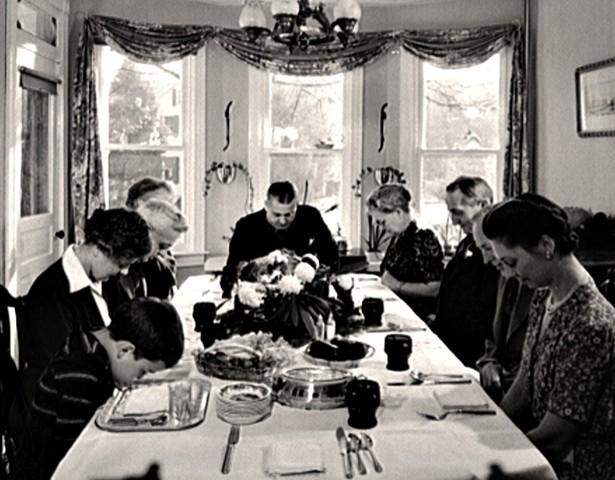
Contributed by Debra Mason
(April 12, 2016 | Source: Emma Green, The Atlantic) - A recent Pew Research Center study indicates that the faux pas of the impoliteness of talking about religion and faith in public continues to hold true for those who are both religious and nonreligious. In fact, of the those sampled, only approximately a third of Americans who claim to be religious choose to talk about the subject with others even once or twice a month (Green, 2016). In general, evangelical Protestants and individuals attending historically black churches were more likely than Jews, Catholics, and mainline Protestants to discuss religion with others. However, this tendency to talk about faith is increased when confined to immediate families (Green, 2016). This study could not establish causality, as would be expected; however the follow-up question of “What should people do when they disagree about religion?,” proved to provide some insight into how people handle religious diversity. Two-thirds of those surveyed agree that is of benefit to “’try to understand and agree to disagree’” (Green, 2016).
While there appeared to be an overall desire to converse about diverse religious perspectives, approaches were partially impacted by denomination. 44% of those who were not religious said it was best to avoid discussing religion, with 31% of Catholics in agreement on this stance. Additionally, 44% of Jews and 25% of Christians believe it is beneficial to avoid discussing religion with those of differing views. “Roughly 10 percent of people who pray daily and attend services weekly say they’d try to persuade someone who disagrees with them about religion, although only a very small percentage of comparatively less religious people said the same” (Green, 2016). These perspectives seem to be especially driven by the desire to avoid conflicts and disagreements with others, as these differences are deemed to drive apart individuals instead of bringing individuals together with found commonalities. Read more
PUBLICATIONS
Coen: Framing religion in Amoral order
By Elijah Siegler
The Coen brothers have created what are considered by many to be some of the greatest
American films in history. However, as is the case with most forms of entertainment, there are
mixed opinions regarding the Coens as filmmakers, both regarding the content of these
productions as well as their roles in looking upon the characters in their films with “artful
contempt” (Siegler, p. 2-3).
Film critic, Pauline Kael, is quoted as saying that “…their films are ‘all flash and no substance…’” (p. 2-3). Yet, other critics believe the Coen brothers take on a “biblical” moralist approach regarding good and evil in their films. “Most of their films contain references to the Bible, whether direct quotations or indirect allusions” (p. 10). Siegler’s Coen:Framing Religion in Amoral Order analyzes several of the Coen brother movies’ connections to religion, investigating the themes of morality, greed, and self-interest in the storylines.
Click here to read about this book.
Contributed by Debra Mason
Seeing spirituality in Chimpanzees
Contributed by Debra Mason
(Barbara J. King, March 29, 2016 | The Atlantic) - Although chimpanzees are our closest living relatives, it would not be immediately assumed by the general public that they would be spiritual. Yet, recent studies have caused some to question this prospect. Hjalmar S. Kuhl and Ammie K Kalan led a team of scientists from Max Planck Institute for Evolutionary Anthropology in publishing a paper entitled, Nature, that suggests the possibility that chimpanzees “…may perform a ritual when they repeatedly throw stones at trees in the forest” within four sites in West Africa (King, 2016).
Jane Goodall had always defined “…spirituality as the experience of appreciating magnificent, unknowable powers at work in the world beyond ourselves,” and this is exactly what is being contemplated in this research as the same stones and trees were repeatedly used throughout this observations (King, 2016). These scientists are considering the possibility that these chimpanzees are utilizing this act in order to sacredly mark trees, similar to the cairn-building within the region (King, 2016).
Though the scientists never articulate the word “spirituality” in their paper, it is acknowledged that this act is similar to human behavior at “sacred” trees (King, 2016). One of the scientists conducting this research, Laura Kehoe, went as far as to suggest in a later post (outside of the paper) that perhaps these trees serve as a chimpanzee “shrine” (King, 2016).
However, not everyone is convinced that chimpanzees are actually demonstrating their spirituality, or possible belief in God, through these actions. USC biological anthropologist/chimpanzee researcher, Craig Stanford, believes that attributing this “ritualized behavior” to spirituality “…is simply silly” (King, 2016). King, when asking Donovan Schaefer, the author of Religious Affects: Animality, Evolution, and Power, about this study received the following response:
“People will always debate what is and isn’t sacred, what counts and what doesn’t count as religious. But if we encountered a group of humans who returned to the same trees over and over and performed the same inexplicable action near them and didn’t seem to have any practical reason to do so, there would be lots of people who would interpret it through the prism of religion” (King, 2016).
LGBT politics of Christian colleges
By David Wheeler
(March 15, 2016 | The Atlantic) - While many Christian colleges have traditionally been against same-sex attraction and same-sex intimacy, policies and customs are adjusting with the new gay marriage legislation (Wheeler, 2016). Most have made it a point to clarify that they are welcoming of homosexual students.
However, some of these policy changes are clearer than others, with a few resulting in what is perceived as double standards for students of differing sexual behaviors. While some schools have not changed their stances regarding same-sex behaviors and even kick students out for gay relationships, others have removed any legislation restricting same-sex dating or marriage (Wheeler, 2016). Additionally, at least two schools “…added sexual orientation to their nondiscrimination policies,” despite having to accept that they would no longer be members of the “…most prominent…organization of evangelical universities” (Wheeler, 2016). Read more
How one Muslim artist is challenging stereotypes about Islam
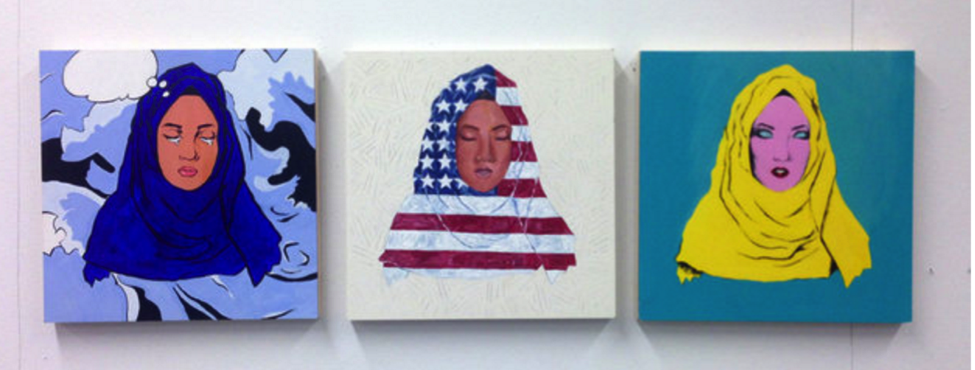
By Antonia Blumberg
(March 3, 2016 | HuffPost Religion) - 20-year-old Azzah Sultan, originally from Malaysia, wants to use her art to fight Islamophobia. Having been a student since the age of 16 at the Parsons School of Design, she has been frustrated by the negative view of Muslims and the Islam religion that is proliferating throughout the United States. Sultan has used many of her art pieces to combat this negativity towards Muslims/Muslim-Americans. In one special project, Sultan utilized the social media in a unique way, asking Muslim women to donate red, white, or blue headscarves so that she could subsequently stitch them together to form her piece that she calls “Home Sweet Home” (Blumberg, 2016). She stated that “her hope with the piece was to show that ‘being a Muslim does not make one any less an American’” (Blumberg, 2016). Read more
Women relatively rare in top positions of religious leadership
By Aleksandra Sandstrom
(March 2, 2016 | Pew Research Center) - Even though women may be technically allowed to be leaders in many large religious organizations, this does not mean they often hold the top positions in these organizations. After examining nine major religious organizations in the United States, Sandstrom and the Pew Research Center found that only four had women in the top leadership positions in the past or currently (Sandstrom, 2016). The American Baptist Churches USA have a woman serving as the General Secretary, and a woman currently serves as a Presiding Bishop at the Evangelical Lutheran Church in America (Sandstrom ,2016). The two organizations who have had women leaders in the past are the Episcopal Church and the United Methodist Church, serving as the Presiding Bishop and the President of the Council of Bishops respectively (Sandstom, 2016). Additionally, while the Union for Reform Judaism (one of the organizations included in the study) has not had a woman president, the Central Conference of American Rabbis does have Denise Eger, a woman, serving as the president of the organization. Read more
Harvard launches free online class to promote religious literacy
By Antonia Blumberg
(Feb. 19, 2016 | HuffPost Religion) - In light of the attacks of extremist groups such as those of 9/11 and the recent attacks on Paris, people have sought answers in the midst of the dispelling of the alarm that often accompanies stereotyped views of the Islamic faith. In order to educate the public and promote understanding of the world’s religions, six “…professors of religion from Harvard University, Harvard Divinity School and Wellesley College…” have taken the initiative to begin an online series to stimulate religious literacy and work to combat the inherent biases that often accompany fear (Blumberg, 2016). “Religious Literacy: Traditions and Scripture”, the first course to be offered on the edX, the platform that will house this course, “…will include six classes on different subjects that will each run for four weeks” (Blumberg, 2016). While the course is free of charge for those auditing, a “…certificate of achievement…” can be obtained with a $50 charge by individuals who choose the option of the “non-audit track” (Blumberg, 2016). Read more

